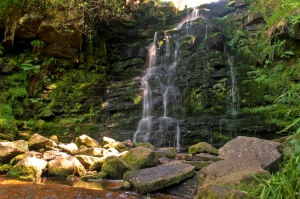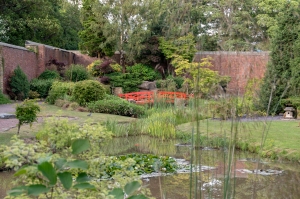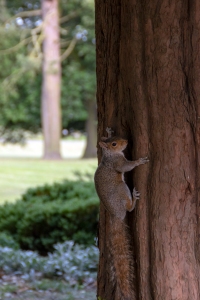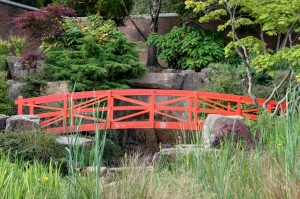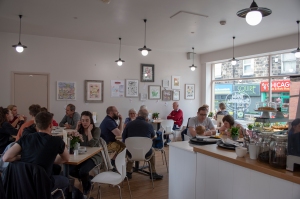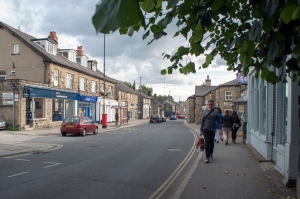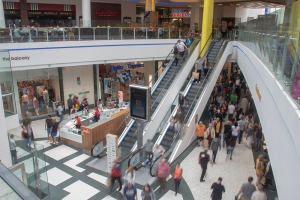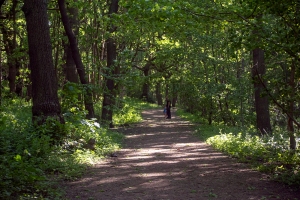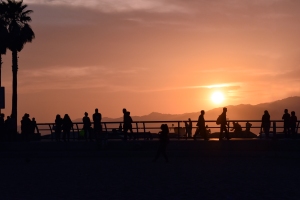For this final assignment, the choice of subject is yours; the only proviso is that the subject
should be one from this course – people and/or the places they inhabit.
First decide on a notional client. Choose the kind of client (newspaper, magazine, text book
publisher, advertising agency, television graphics, etc.), the purpose of the assignment
(educational, informational, promotional) and how the images will be used (to illustrate a
story, to sell a product etc). You choose.
You then need to imagine what the basic brief would be, which will mean thinking from the
other side of the fence — what someone commissioning a photographer might want. Write
yourself the brief so that you can refer back to it.
Having assigned yourself the brief, you now need to complete it. You need to submit
between 8– 12 photographs. Accompany the final images with a short written assessment.
This should include:
• The ‘client briefing’ that you gave yourself
• A statement of how you set about planning the photography
• How well you succeeded, including the difficulties and opportunities you encountered
that you had not anticipated at the outset.
The Brief
Company: The Greek Trail
Title: ‘Chanian Charm’
We would like you to visit the Cretan city of Chania and its surrounding areas.
Our article will require between 8 – 12 varied images depicting the quaint charm of the city and its surroundings; focusing less on tourists as a central subject, and more on the location itself.
Please note:You are not required to eliminate tourists completely.
Our aim of this article is to entice people to visit Chania and to appeal to those who prefer to explore ‘off the beaten track’ so to speak, avoiding overly touristy/busy areas. We want you to emphasise a calm, tranquil, peaceful paradise location.
We would like colour shots, but please note we do not publish any HDR photography.
Preparation
The first thing I did after “receiving” my brief was to pick out the key words I really needed to focus on:
- Quaint Charm
- Varied Selection
- Location
- Avoid Overly Touristy Areas
- Off The Beaten Track
- No HDR
- Colour Images
I then wanted to make a short list of things I would perhaps consider including in my series:
- A long exposure (beach, waves, water)
- A sunset/sunrise/twilight/nighttime shot
- A small local street
- A high up viewpoint
- People
- Street cafe/restaurant
- Town/street
- Nature/animals/sea life
After having a vague idea of the types of images I wanted to take I then need to make sure I pack all the relevant equipment:
- Tripod
- Neutral Density Filter
- Wide Angle Lens
- GoPro
- GoPro Dome Housing
- Multi Lens
- Lensball
- Remote Shutter
- Multiple Memory Cards
- External Hardrive
- Laptop
- Polarising Filter
- Battery Pack
- Charger
- Spare Batteries
- Camera Cleaning Kit
From the outset I was excited at the prospect of carrying out this assignment. Travel photography is the direction I naturally seem to find myself leaning towards, and with a brief such as this I couldn’t wait to touch down on the tarmac.
For the first day or 2 my main focus was finding the lay of the land and location scouting (as well as relaxing, of course). I did not want to enter into this assignment blindly, but rather have some kind of knowledge of my subject/locations – I felt it imperative to include as much variation as possible.
After reviewing my sub categories mentioned earlier I visited my chosen locations and began shooting…
Once I returned home I began to file all my photos into specific categories which would hopefully help me whittle down through the images to reach my final selection.
The categories were:
- Sunset
- Chania Harbour
- Chania Old Town
- Nightscene
- Ocean
- Restaurant
- Streets
- Beach
- People
The Old Harbour

I’m delighted with how this image came out. I wanted to take a long exposure shot that would result in the water looking soft and silky and not choppy as it was on the day. High winds were causing an unusual amount of movement in the water. This technique of softening moving objects, especially water is often used in travel photography.
I wanted to photograph this scene just before sunset in the hope that I could capture the different hues in the sky and at a time where the shops, restaurants and street lights had were on – adding depth to the image while also reflecting in the water. I opted for ‘shutter speed priority’ mode on my Nikon and set a shutter speed of 10 seconds. I had my neutral density filter on; at a mid range of 5 which meant I could use a longer shutter speed at that time of day.
I used a moderately wide angle lens as I wanted to fit as much in as possible. I positioned my camera (fixed onto a tripod) fairly low to the ground in order to get plenty of the harbour in. There’s several different layers/elements to this image. The buildings on the far right are in shade and appear fairly dark, which is in contrast to the buildings on the left which are much brighter. If you cast your eye along the buildings from either direction it creates a gradient effect, which is also clearly apparent in the sky.
The light reflections in the water are also much more prominent to the right of the image and fade off as you move your eye to the left of the image, again creating a gradient effect.
A Natural Paradise

Perhaps one of the more challenging images in regards to physically getting the shot but I’m so pleased with the end result. This was in fact taken on my GoPro Hero 5 using a dome housing case which enabled me to execute a split land/sea image.
From the outset I knew I wanted to incorporate an image such as this, and there is only so far into the sea you can go with an expensive DSLR (unless you’re fortunate to have a waterproof housing case!) hence shooting on my GoPro.
This image needed careful planning and attention. I settled on a location that I knew would have some form of reef/coral that would add plenty of depth and interest to the image. After finding the perfect location, I needed a speedboat and a snorkel – this really was a fun photo to shoot, and I felt like I could have been on a real photographic assignment!
I did shoot several other images around this area and some incorporated only the open sea, but they just weren’t as engaging as those with the reef.
I’m so pleased with how vivid the colours are and that I’ve managed to capture enough of the land above water as well as below. This image was always going to weigh much more on the aesthetic side than the actual technical side, as shooting with a GoPro significantly reduced the amount of technical control the photographer has.
However I did not see this a set back in any way as it has produced exactly what I was hoping for. I did decide on selecting a wide angle framing option as this meant I could capture as much of my surroundings as possible, and it may be responsible for adding the slight curve to the water level ( something I find aesthetically intriguing, as it could work as a visual interpretation of the earths curve) or this could have been due to the curvature of the dome itself, or perhaps both.
Dining Al Freso

I wanted to include some variation of a restaurant/dinner picture. Photographing people actually eating can often result in some unflattering facial expressions, and I decided to refrain from photographing food itself, as this ‘brief’ was more about location.
I found this gorgeous restaurant hidden down a tiny side street, that produced a gorgeous backdrop of lush green plants and a historical stone wall.
I did not want to intrude on this couple’s romantic meal, so opted to position myself further back and zoom in slightly. I positioned myself to the far right of the diners as there was a steady flow of foot traffic to the left which I did not want to include as I feared it would be somewhat distracting. I did however want to keep a faint hint of the bustling vibe, and this is evident with the people in the background and the overall busyness of the picture.
I waited for a moment where there was a fairly substantial amount of hand gesturing, as the image was much less aesthetically interesting when they had their arms/hands by their sides. The waitress waiting on the table in the background adds another layer/dynamic to the image which I like. You cannot see her face either, which draws attention to the diners who are the main focal point of the image.
Chania At Night
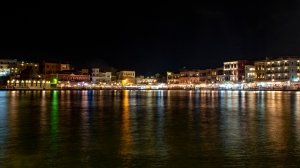
I was adamant I wanted to photograph the harbour at night as well – adding variation to my final set of images while also adding a contrasting element of time of day. It’s amazing how different a scene can look within the space of only an hour or so. I used a different angle to the previous harbour image, turning my attention towards the centre of the harbour.
Again I wanted to take a long exposure image to render the water slightly softer/silkier, plus technically speaking a longer shutter speed would be required anyway due to the diminishing available light. I used a shutter speed of 8 seconds.
I’m very happy with this image. I had in my minds eye an almost black sky and harbour with the exception of the street/building lighting and the light reflections in the harbour creating long thin visual streaks in the water.
I wanted to position the land in the centre of the image horizontally speaking to create a sense of balance, and also a sense of ‘mirror’ imagery/symmetry. In the final edit I cropped the shot to a ratio of 16:9 as I felt this creates a ‘cinematic’ feel and is a technique often used in travel photography.
Again I used a fairly wide angle as I wanted to fit as much of the scenery in as possible. In hindsight I could have perhaps used my neutral density filter which would have increased the optimum length of exposure and selected a longer shutter speed to create even more blur in the water, but at the time I did not see this as being necessary.
Little Bright Backstreets

What instantly grabbed my attention with this little side street was the potted plants contrasting with the white walls and serving as a guide to help the eye move down the street towards the bend. I was searching for a street that curved round, making the imagination wander.
I love how the light captures different areas of this scene. My positioning is in the shade, yet the far white and terracotta walls are both bathed in sunshine. There’s a hint or laundry hanging in the salty air drying at the top of the image – a stereotypical image synonymous with small European villages/towns.
I was very briefly joined by a young girl who was making her way downstairs, but unfortunately she scrambled back indoors as soon as she saw my camera. I would have loved to have incorporated her moving down the stairs, and a little more visually apparent, but this is what happens when you are shooting on the move and in public. I am still very aware that people may not wish to be photographed, and that my presence may unnerve them.
Still, I have decided to keep her partially visible, as the flash of blue from her outfit adds a lovely discreet splash of colour.
Catch Of The Day

With Chania and it’s surrounding areas being on the coast, many of the locals are fishermen and head out day and night to catch the freshest fish to supply the local restaurants.
I wanted to photograph a fisherman preparing to leave the harbour so headed out early one morning to the small pier in the village of Kalyves. (Chania’s harbour is not used in this sense anymore, but in more of a commercial way these days.)
I love the no frills feel this image has. His boat is not state of the art and he doesn’t have the newest equipment. It’s a true representation of rural Crete and of the majority of the fishermen and boats that you often see heading out for a days fishing.
My positioning was a little restricted as there’s only a small footpath/jetty to allow access to the boats and this is the only thing I could stand on. I was lucky to capture him almost face on as he turned his back to sort through more equipment right after sorting out the buoys, and I wouldn’t have been able to capture his features.
Thankfully I was positioned to the fisherman’s right, which meant I was able to include some of the harbour background and water which adds another element to the image. Had I photographed him from the left it would have eliminated these aspects.
These Streets Are Made For Strollin’
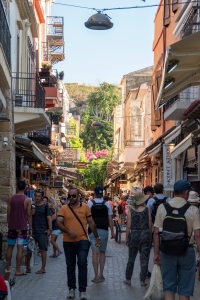
The backdrop to this street was undeniably gorgeous. So much so that I knew it had to make it into the final selection. The light was casting on the furthest end of the street meaning the gorgeous greenery was lit up, while the street and passers by were in a slight shadow, which I think draws your attention to the stunning mountainous backdrop.
The street itself is full of beautiful little tavernas, bars, hotels, hostels gift shops and restaurants. As my main focus of this image is the distance, I waited for enough foot traffic to render the shop fronts unrecognisable, aiding the viewers eye to settle on the greenery; which I had positioning in the middle of the frame.
I love the juxtaposition of the man in the orange and his surrounding passers heading in the opposite direction. It adds a sense of balance to the image.
Taking In The View
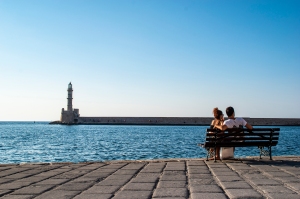
At first I was considering taking this image once the couple had left, and predominantly focusing on the lighthouse and the water. However, as soon as I walked past the bench I feel in love with this potential shot.
The direction of their gaze adds intrigue as the object of their attention is out of the frame. It contrasts nicely when referring to the ‘weight’ of the image as they balance out with the lighthouse itself. I positioned myself very low to the ground in order to incorporate the traditional paving slabs that are still existing to this day.
There’s also a suggestion of irony – the gorgeous historical landmark in front of them is not what has caught their attention. In fact the lady especially is turned so much to the right that she almost has her back to the lighthouse.
I would have liked to have included their full shadow cast on the ground, but unfortunately there was a large group of tourists positioned just out of shot to the right.
This image demonstrated to me that subtle simplicity can be a very powerful tool in photography.
Paradise In The Palm Of Your Hand

This selection of prints wouldn’t have been complete without a sunset picture. I wanted to ‘zhuzh’ up the bog standard sunset pic, so decided on incorporating one of my favourite photography props; my lensball.
I was aiming for a ‘double effect’ picture. A picture of a gorgeous sunset, with the gorgeous sunset mirrored in it – so naturally my lensball was the perfect tool. While researching exotic travel publications it was fairly common to see reflective techniques being used to enhance a certain object. A reflection in sunglasses or a wine glass perhaps.
The tricky thing about photographing with my lensball is that it only leaves me with one hand free. After a few practise shots it’s fairly easy to master, and the trick it so lock the focus within the ball.
I made sure I positioned the horizon within the ball in line with the true horizon as I think this type of continuity or fluidity is paramount in producing an image such as this. Your eye follows the natural line of the horizon from left to right. Had the lensball been lower I don’t think the image would be as pleasing at it would appear broken up.
Including one image with my lensball did lead me to question whether more images should have included the prop, but the only considerable draw back, per say, about using the lensball is that it produces fairly similar images.
A Path To Paradise

I stumbled across this beach entrance by chance, and had to stop in my tracks to photograph it. These are the side streets I knew I had to find. The tiny little offering of blue water just beams serene tranquillity. I had wanted to capture it without anyone walking up or down, as this would significantly eliminate the sea from my shot, but luckily this path was uninhibited for the duration of my shoot.
I love the bright pop of colour courtesy of the two large bushes on the walls, and how all of the plant life appears staggered in the image. They almost frame the sea view.
Again I wanted to incorporate the cobbled pathway, which aids in leading your eye to the beach. Another gorgeous little detail is the bicycle leaning on the right wall at the far end – bicycles are, for me, always synonymous with quaint foreign seaside traditional villages.
……………………………….
I decided on choosing my 10 strongest images. In past assignments I have gone for the maximum amount required and I’ve added some shots that aren’t perhaps as strong as others, or I’ve included shots which are too similar to others.
While photographing this assignment I encountered a huge technical problem that I was not initially aware of:
After travelling to Chania’s old town I spent an evening photographing the harbour as the sun was setting, and a series of long exposures as day turned to night. As I was photographing, the images were displaying on my LCD screen so I could review it, make amends and re-shoot if necessary.
It was only once I was back at my hotel and tried to view them properly that I was getting an error warning that my memory card was in fact damaged. I was mortified. The data had obviously saved in some sense, as the files were there, and I’d seen the images on my LCD preview display.
But the files were corrupt and there was no way of retrieving them. This was a huge blow for me. I’d taken several spare memory cards in case of damage, or a full memory card etc but I had not prepared myself for a situation such as this – a situation where I was completely oblivious to a huge underlying technical issue. Luckily, it was not the whole memory card that was damaged, so all was not lost. I also decided to return to the harbour and re-shoot, an option that I was lucky enough to have.
This really opened my eyes to the difficulties that can be faced while photographing on location. Had I not been able to return and re-shoot, some of the strongest images I’ve ever taken would have been lost, and if this were a real photography job my client would have received work that wasn’t my best work.
I now make sure to review my library on my Nikon regularly, and not solely relying on the quick review option my camera offers.
Assessment criteria
Demonstration of Technical and Visual Skills:
I am very pleased with both my technical and visual execution of this assignment. I’ve applied multiple techniques in order to produce the images I had visualized; such as long exposure shots and split water shots.
I imagined the photographs to be relatively tranquil and refined, and wanted to avoid overly crowded images as this was implied in the brief. Therefore I searched for opportunities and locations that would provide this, and selected my locations based on their visual criteria.
There was one image in particular that was technically challenging in that I had to use precision timing and positioning in order to get ‘the shot’ that I had visualised.
These images had to be visually appealing as they were being used as promotion for a travel publication. That meant I wanted to focus on colours (but not too much, or overly saturated colours. It was key to remember that HDR was a no) and focus on the raw/un-spoilt beauty of the location itself.
As with a lot of travel photography I used a wide angle lens to fit as much landscape in as possible, which amplifies the sense of the place and its surroundings.
Quality of Outcome:
I’m very satisfied with the quality of outcome. These prints all come together as a set and have a common theme which pulls them together with a sense of continuity and purpose. I wanted to include several small alley/street shots to add a deeper layer of connection/similar theme. Small streets and alleyways are also an iconic visual ideology of Greek islands, so not including them was never an option.
In terms of the individual images I’m happy that each one of my photos is a strong representation of my brief, and the images are able to stand independently, as well as part of a series.
There are several shots that perhaps stand out more, creatively speaking, than others. Specifically the lensball image and the coral image. These images may be perceived as inconsistent with the collection as a whole, but I felt that removing these images from the set would result in the collection feeling too same-y. The brief is so open ended that I felt it was perfectly acceptable to include them – the brief doesn’t include any details about their readers, so naturally it made sense to include as much variation as possible, appealing to the widest possible audience. Basically, including a little bit of ‘something for everyone’ type scenario.
Demonstration of Creativity:
For this assignment I tried to follow the brief in a simplistic yet creative way. I wanted my creativity to be subtle, as I felt this would suit this kind of brief more. I looked for nice framing options, and characteristics that would amplify my shots. The two images that really demonstrate my personal creative style are the sunset involving my lensball prop and the split water image. Both of which I really wanted to include for the purpose of developing my creativity. I think the other images portray a much more traditional and classical sense of creativity in their subtlety.
In terms of developing my personal voice this assignment gave me the opportunity to push my boundaries technically. I used equipment and techniques which were either completely new to me, or that I was unfamiliar with. This kind of practical experimentation is paramount in me developing my creativity and finding my own style.
Context:
There were no actual exercises within this last section of the module, so I spent most of my time researching travel photography, travel brochures and studying techniques used in such photography. I also researched the area I would be travelling to, and the subsequent surroundings.
I have been fairly limited with time for this module, as I was struggling to meet my deadlines and allocate enough time towards my studies. However, I have made a vast conscious effort to put aside regular time slots of my working week and weekends to pursue my studies. I’m submitting all my assignments on time, and feel I’ve settled on a manageable balance of my time.
I’m still working on my confidence when photographing people, and this assignment was a great boost for this. Photographing in a touristy area really reduces the sense of intruding on people’s personal space. It is so common to see people taking photos and holding cameras.
I’ve also been reading up on long exposure photography and have been experimenting with photographing waterfalls. These posts are on my blog.
As always I find myself studying my surroundings and people much more since doing this module. I am constantly seeing great photographic opportunities – focussing more on people and how they interact with the spaces around them.
I struggled to really engage at the beginning of this module, but by the end I felt a strong connection with my briefs and the ideas behind them.


























